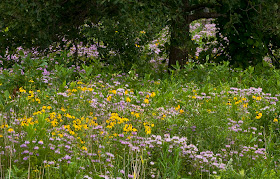Wednesday, August 7, 2013
Plant of the week: Wild Bergamot (Monarda fistulosa) and Gray headed coneflower (Ratibida pinnata)
This week there are two plants of the week because they should definitely be grown together and provide a color palette that is outstanding (yellow and lavender). I guess my reason for talking about these plants comes from my recent trip back from South Dakota where these plants dominate the tall grass prairie and roadside plantings in Illinois and Iowa. Both species obviously flower about the same time (actually in mid-summer here in Kentucky) and are for the most part disease resistant (although wild bergamot has a tendency to develop powdery mildew) and can tolerate the typical nasty clay soils of urban development. They are also tolerant of deer browsing and are excellent cut flowers, even providing some nice fragrance in the process. Finally, these two species are easy to grow and establish and will flower for an extended period of time. Both like full sun and can tolerate a wide range of soil conditions. Because these grow up to 3 - 4' tall, never fertilize or water them and if grown together, there is no need for staking as each other will provide support. The primary pollinators of the yellow coneflower are various bees some wasps and small beetles and butterflies. This is a host plant for the silvery checkerspot butterfly. Bergamot has an oregano-mint scent and is visited by ruby-throated hummingbirds, hummingbird moths, skipper and swallowtail butterflies. The primary pollinators are long-tongued bees. This species was, and is still, used to make a tea (usually with honey added because the flavor is so strong) to ward off colds and one of the common names, bee-balm refers to its antiseptic uses as an ointment.

No comments:
Post a Comment